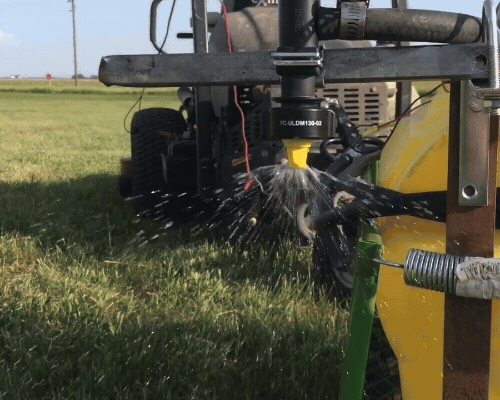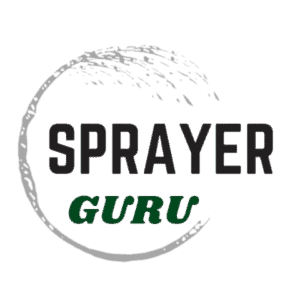You can’t talk about any type of sprayer without talking about pressure. Pressure clearly plays a major role in the performance of a sprayer. However, understanding the relationship between pressure and how your sprayer performs can be a little confusing.
Today our goal is to examine how pressure affects a sprayer’s performance and clear up any misconceptions you may have about pressure. We will cover things like what happens when you increase or Decrease pressure and why some sprayers can produce more pressure than others.
Why Pressure Matters When Spraying
Regardless of the type, Pressure in a sprayer is crucial for several key reasons. Pressure directly impacts the effectiveness, efficiency, and functionality of a sprayer. These are the specific effects that pressure can have on a sprayer’s performance:
- Flow rate
- Spray nozzle pattern and coverage
- Droplet size
- Canopy penetration
- Spray distance
Let’s examine each of these in more detail.
Control of Flow Rate
Pressure dictates the flow rate of the liquid being sprayed. Higher pressure can increase the flow rate and lower pressure will decrease the flow rate. Specifically, if you want to double the flow rate you need to quadruple your pressure. If speed stays constant, higher pressure results in a larger volume of liquid applied over a given area and a lower pressure means a lower volume.

This is essential for applying the correct amount of product (like pesticides or fertilizers) over an area. If you change your speed you can increase or decrease pressure to maintain the same output. You can see more details in this guide on sprayer output.
Managing and controlling your rate is a complicated topic. That is why I wrote a full article that covers sprayer rate control in detail.
Spray Pattern and Coverage
The pressure at which a sprayer operates significantly affects the spray pattern and the coverage quality. If pressure is too low, your sprayer nozzles won’t produce an even or full pattern. If the pressure is too high, then the pattern can become a fine mist and not hit the target surface.
Different types of nozzles are designed to operate most effectively at specific pressure ranges. For example, flat fan nozzles, commonly used for broadcast spraying, require precise pressure settings to maintain their characteristic even, fan-shaped patterns that provide good leaf coverage.
Air induction nozzles, which are designed to reduce drift by producing larger droplets, also have optimal pressure ranges for achieving the best balance between coverage and drift reduction.
Droplet Size
Pressure influences the size of the droplets produced by the nozzle. Optimal pressure ensures that the spray droplets are of a uniform size, which is critical for achieving even coverage. Too low pressure may result in larger, uneven droplets and poor coverage, while too high pressure can create fine droplets that are easily drifted by wind, potentially leading to off-target application and waste of chemicals.
Different applications require different droplet sizes for maximum efficacy. For example, herbicide applications may require larger droplets to minimize drift, while insecticides might be more effective with smaller droplets that can easily cover the surfaces of plants and reach into crevices where insects hide.
Below, you can see how a change in pressure affects droplet size produced by the same nozzle:


If you would like to learn more, refer to my sprayer nozzle guide which covers the droplet size range in detail.
Penetration
Pressure plays a significant role in how well herbicides penetrate through a crop canopy to reach target weeds. When you crank up the pressure, the droplets shoot out faster. This speed can help push the droplets through the dense layers of leaves.
Turning up the pressure usually means you get smaller droplets while lowering the pressure gives you bigger ones. Smaller droplets can maneuver through the canopy easier and cover more area, but they’re also more likely to drift away with the wind if not managed properly.
Spray Distance
Pressure also plays a crucial role in how far you can project a fluid from a spray gun or wand. This is very important for applications like tree spraying. Essentially, the higher the pressure, the farther you can spray the fluid, but it is a little more complicated than that.
Think of the pressure in your sprayer as the force behind each droplet. The more pressure you have, the more force you’re giving each droplet to move forward. This means that at higher pressures, your spray can reach further distances because you’re essentially “pushing” the fluid harder through the nozzle.
While cranking up the pressure will lead to greater potential distance, it does lead to finer droplets, and at a certain pressure, you will have a mist that does not travel very far and is easily influenced by wind.
You need to have an adequate volume of liquid as well as specialized spray guns to keep liquid in a stream that holds it together so it can travel through the air without turning into mist.
Relationship of Flow & Pressure In a Sprayer
Often people will mistake flow for pressure. But these are two different things. While they are related it is important to know the distinction and understand how they affect one another.
- Flow rate refers to the volume of liquid that is dispensed by the sprayer over a specific period of time. It is typically measured in gallons per minute (GPM)
- Pressure, in the context of sprayers, refers to the force at which the liquid is expelled from the sprayer.
Hang on because I am going to get a little technical for a moment.
The flow rate of a fluid depends on the pressure difference between two points, measured in pounds per square inch (PSI). This relationship follows the principles of Bernoulli’s equation and the continuity equation for fluids that can’t be compressed. Basically, when the speed of the fluid goes up (meaning the flow rate increases), the pressure usually goes down, and the other way around, if there’s no loss of energy.
So how does this affect your sprayer? When the fluid moves through a system, such as pipes and nozzles in a sprayer, it encounters resistance due to friction with the pipe walls, changes in direction or flow speed, and constrictions like nozzles or valves. This resistance causes a reduction in the fluid’s pressure.
How Pressure Loss Occurs
- Friction: As the fluid travels through pipes, it rubs against the pipe walls, causing some of the energy driving the fluid forward to be converted into heat. This energy conversion results in a decrease in the pressure that propels the fluid. The longer the pipe or the rougher its interior, the greater the friction and the subsequent pressure loss.
- Direction Changes: Every time the fluid changes direction due to the system’s layout (e.g., bends, elbows), turbulence is created, which increases resistance and causes pressure drops.
- Speed Changes: When fluid speeds up or slows down, for instance, through a nozzle or a pump, energy is either added to or taken from the fluid. Speeding up the fluid in a nozzle increases its kinetic energy but decreases its pressure, leading to pressure loss in terms of its ability to push the fluid forward.
- Constrictions: Any section of plumbing where the fluid path is decreased will result in a net reduction of pressure. This can reduce the flow rate and the ability of a sprayer to reach the pressure that you want. I discuss this concept more in the spray trailer plumbing guide.
How Pressure Affects Sprayer Nozzle Performance
When the sprayer pump pushes the liquid through the system, it eventually reaches the nozzle, which has a much smaller opening compared to the hose or pipe leading to it. As the liquid approaches the nozzle, it’s under a certain pressure. Once it reaches the nozzle’s smaller opening, the liquid’s velocity increases to pass through this constricted space.
Simply put the pressure at the nozzles is lower than the pressure at coming out of the sprayer pump. So if you have a pressure sensor/gauge mounted in a manifold or a fitting upstream from the boom, this pressure reading will not indicate the pressure at your nozzles.
Knowing the pressure near the manifold can be helpful but it is not as crucial as knowing the pressure of the liquid coming out of your nozzles. The spray angle, flow rate, and droplet size that the nozzle produces are directly related to the pressure of the fluid going through the nozzle.
It is important to test the actual flow coming out of your spray nozzles to accurately determine what operating pressure gives you the output needed to achieve your rate. For more information, check out this beginner’s guide to selecting a nozzle for a boom sprayer.
How to Determine Sprayer Operating Pressure
The best way to learn how much pressure loss is occurring in your system, and what pressure you need to operate at is to test the output of your spray nozzles.
Sprayer nozzles are rated to deliver a specific volume at 40 psi. For example, sprayer nozzle size 04 delivers 0.04 gallons per minute at 40 psi.
However, if your pressure gauge reads 40 psi, likely, the pressure is not 40 psi at the spray tip. It is likely less so your actual flow rate is not 0.04.
Holding a measuring container under a spray nozzle to catch fluid as you run a sprayer for a minute allows you to discover the actual output when your sprayer pressure gauge or pressure sensor reads 40 psi. Then depending on how far off you are from your desired application rate you can increase the pressure and run this test again. Continue this until you have zeroed in on the actual operating pressure your sprayer needs to be out to achieve your desired output.
Be sure to read this article for more information on how to choose your sprayer operating pressure.
Flow and Pressure for Sprayers with Handguns
The relationship between pressure and flow rate is not just significant for boom sprayers but also for sprayers where you use a trigger gun or spray wand. Turf sprayers and tree spray rigs rely on pumps that produce a high Combination of pressure and flow rate to project fluid from a sprayer gun at great distances.

It takes force to spray the liquid high enough, but also stability in the spray pattern to maintain a solid stream that does not become mostly fine droplets and mist. This is why the gun and nozzle design are also important.
Conclusion
Pressure is one of the most crucial factors for sprayer performance. Understanding how pressure impacts the different aspects of effective chemical application will help you achieve the best possible results.

